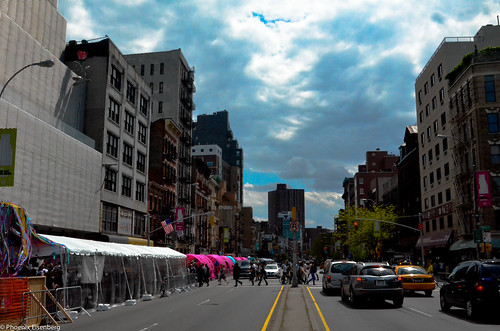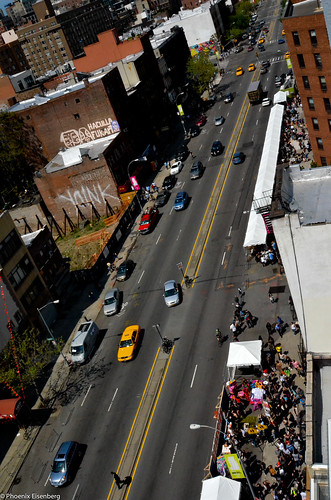The range of life forms seen around the East Village and Lower East Side this past weekend was pretty astonishing, when you think about it: all the way from top-rank architects, artists, and scholars to bees and worms.
The Festival of Ideas for the New City hosted over 100 events, from small gallery projects to expensive international design competitions, and put a spotlight on this neighborhood’s enduring artiness, earthiness, and connectedness. Organized by the New Museum of Contemporary Art and ten other partners (listed at the festival website), the Festival was part multimedia art show, part kid-friendly community fair, part academic conference, part urban design charrette, and part intellectual pub crawl.
It’s easy to tire of the kind of NYC booster who constantly tells out-of-towners “you name it, we’ve got it here,” but during the Festival, particularly the Streetfest component last Saturday, the well-worn phrase really did apply. Humongous translucent bubble full of urban-design visionaries, some adrenalined-up enough to leap onto chairs and quote poetry? Check. Pop-up buildings resembling worms? Check. Person dressed as enormous yellow worm, hugging passersby at the Lower East Side Ecology Center’s table while her colleague Kaity Tsui, winner of the first-ever “Greenest New Yorker” award from the state’s “I Love NY” campaign in 2010, hands out “Hug a Worm” buttons and promotes home composting? Check. Eighteen-foot “Girlzilla” robot built by kids at the Lower East Side Girls’ Club? Check.
The Festival frequently looked in opposing directions: to the city’s sepia-toned history and to futures that make the Jetsons look like the Flintstones; to the latest wireless networks and to the soil; to humble do-it-yourself recycling projects and to global capital (the Festival’s funding sources included Audi, American Express, the Rockefeller Foundation, and Goldman “Vampire Squid” Sachs). The ideas driving the city of the future, it seems, won’t all be hippie-innocent and will include a few contradictions. This hasn’t historically bothered New Yorkers all that much (most famously, Walt Whitman); around the Festival it was less a cause for concern than grist for more conversation.
Events launched last Wednesday with an enjoyably provocative talk by Dutch architect Rem Koolhaas, founder of the Office for Metropolitan Architecture and winner of the Pritzker Prize (architecture’s equivalent of the Nobel). The Cronocaos exhibition by OMA and its research branch AMO opened at the New Museum over the weekend, and Koolhaas presented its central argument: that historic preservation isn’t an antagonist of modernism but a key component of it, a nuanced problem with a specific history, deserving close case-by-case analysis rather than simple us-versus-them allegiances.
Panels at Cooper Union on a series of interlocking themes, the Heterogeneous City, Networked City, Reconfigured City, and Sustainable City, offered ample opportunities for blue-sky thinking and a few victory laps over adaptive-reuse achievements like the High Line, plus an occasional alarm bell over undemocratic uses of technology. These aren’t just hypothetical future scenarios, systems designer Adam Greenfield of Urbanscale noted, but real parts of people’s lives.
He described several levels of existing locative media creating “the networked now,” from beneficial, unobjectionable safety devices like Finland’s Välkky traffic-sensing system to increasingly annoying, prescriptive, and intrusive applications that bombard people with unwanted advertising and surveillance. When power resides in computer code and the slippery slope toward an Orwellian state is only a couple of upgrades away, Greenfield suggested, we need a revitalized public sphere that can take action preserving our rights and our sanity.
The prevailing mood around the Festival, however, was far from ominous. Mayors of cities large and small described innovative approaches to urban problems. Some of the most optimistic appeared in a keynote by Antanas Mockus, former mayor of Bogotá, Colombia, not a career politician but a mathematician/philosopher by profession. Drawing from Russian Formalist critic Viktor Shklovsky’s strategy of estrangement, or “making the familiar unfamiliar” and vice versa, Mockus blends surrealist art with public policy, often comically, to shake people out of “grey” routines and antisocial behavior, strengthening a cultura ciudadana or culture of citizenship. (Memo to Mayor Bloomberg: you could do worse than snag some ideas from this guy.)
Amid all the heady eco-techno-futurism at Openhouse and on the street, some Festival events drew attention to much older ideas that are surprisingly adaptable to modern urban conditions. In a quiet policy change, city government legalized urban apiaries last March, and Bowery Poetry Club proprietor Bob Holman is taking them up on it: Sunday’s events included the ceremonial installation of a rooftop hive by Sam Comfort of Anarchy Apiaries in Germantown, NY.
The idea came from the Atlantic Center for the Arts, where Holman serves on the national council, and where guest artists participate in beekeeping for both fund-raising and connection to nature. “Today was a day we’ve been planning for about a year,” Holman said. “On the slow Sunday after the main day of the Festival, we thought, what nicer way to kick back and have a more pastoral feeling than to unveil the Bowery Beehives…. real simple and ancient methodologies, but still useful.” The bees will pollinate plants throughout the city’s ecosystem, returning to the BPC roof each night, and may produce fresh honey in about a year.
Do bees – stressed by the unnatural demands of industrial agriculture, but resilient and productive when treated well – have anything in common with local artists, driving the creative sector of the economy, occasionally gathering at events like the Festival as if in a humming hive? Holman approves the metaphor: “And, of course, the poetry is the honey, and that’s what feeds our souls.”






